Cost-Benefit Analysis of Hybrid Photovoltaic/Thermal Collectors in a Nearly Zero-Energy Building
Abstract
:1. Introduction
2. Description and Modeling of the Case Study
2.1. Energy Requirements of the Building
2.2. Modeling of the System
2.2.1. Modeling of the Heat Pump
2.2.2. Modeling of the Thermal Storage
2.2.3. Modeling of the PVT Collectors
2.2.4. Control Strategy
3. Multi-objective Optimization Problem for the PVT System
3.1. Formulation of the Multi-Objective Optimization Problem
3.2. Results of the Multi-Objective Optimization Problem for the PVT Collectors
- Cost of saved energy (CoSE): Ratio between the installation costs and lifecycle saved energy with respect to the non-solar configuration;
- Fraction of energy savings (FES): Percentage increase of energy savings with respect to the non-solar configuration;
- Primary energy ratio (PER): Ratio between the useful energy and the net non-renewable primary energy input;
- Profitability Index (PI): Ratio between the difference of total costs between the chosen configuration and the non-solar configuration and installation costs for the specific configuration.
- For the thermal balance of the thermal storage:
- ○
- Thermal production from the PVT collectors,
- ○
- Hours of thermal energy production,
- ○
- Equivalent hours of thermal energy production, , where the number of hours of thermal energy production is divided by the nominal thermal capacity of the PVT collector and the number of PVT collectors
- ○
- Thermal efficiency,
- ○
- Average thermal storage temperature, .
- For the electrical balance:
- ○
- Electrical energy provided by the PVT collectors,
- ○
- Hours of electrical energy production,
- ○
- Equivalent hours of electrical energy production, , where the number of hours of electrical energy production is divided by the nominal electrical capacity of the PVT collector and the number of PVT collectors
- ○
- Electrical efficiency,
- ○
- Average cell temperature, .
4. Comparison of the PVT System with the Solution with ST and PV Modules
4.1. Methodology
4.2. Results and Comparison
5. Conclusions and Future Works
Author Contributions
Funding
Acknowledgments
Conflicts of Interest
Nomenclature
| BOS | balance of system |
| COP | coefficient of performance |
| COPid | ideal coefficient of performance (reversed Carnot cycle) |
| CoSE | cost of saved energy [€/kWh] |
| DHW | domestic hot water |
| EER | energy efficiency ratio |
| EERid | ideal energy efficiency ratio (reversed Carnot Cycle) |
| FES | fractional energy savings (see definition in ISO 9488:1999 “Solar Energy—Vocabulary”) |
| HP | heat pump |
| HVAC | heating, ventilating and air-conditioning system |
| NZEB | nearly zero-energy building |
| PER | primary energy ratio |
| PI | profitability index |
| PV | photovoltaic system |
| PVT | photovoltaic/thermal collectors |
| ST | solar thermal system |
| TS | thermal storage |
| αs | solar absorptance | |
| α1 | first coefficient for the determination of the PVT thermal efficiency | [W/(m2·K)] |
| α2 | second coefficient for the determination of the PVT thermal efficiency | [W/(m2·K2)] |
| βT | PV/PVT penalization factor depending on technology | [%/°C] |
| ε | efficiency of the heat exchanger | [-] |
| η0 | zero-loss PVT thermal efficiency | [-] |
| η | efficiency or heat loss utilization factor | [-] |
| β | PV/PVT/ST slope | [deg] |
| γ | PV/PVT/ST azimuth | [deg] |
| λ | thermal conductivity | [W/(m K)] |
| ΔU | variation of internal energy | [kWh] |
| ρ | density | [kg/m3] |
| system lifetime | [yrs] | |
| (τα)n | transmittance-absorptance product for normal-incidence irradiance | [-] |
| 𝜙i | characteristic time shift of the i-th external wall | [h] |
| building time shift | [h] |
| * | referred to sol-air temperature |
| MAX | maximum |
| II | second-law efficiency |
| b0 | incidence angle modifier coefficient for single-cover ST collectors | [-] |
| CTOT | global cost | [k€] |
| Cin | installation cost | [k€] |
| c | specific heat | [kJ/(kg·K)] |
| specific cost of the technology/energy | [€/kWh] | |
| E | energy | [kWh] |
| primary energy factor | - | |
| FR | ST removal factor | - |
| Hve | equivalent ventilation-thermal transmittance | [W/K] |
| h | hours | [h] |
| he | external heat transfer coefficient | [W/(m2·K)] |
| heq | equivalent hours | [h] |
| Isol | global solar irradiance | [kWh/(m2 day)] |
| Kt | hourly clearness index | [-] |
| NOCT | nominal operating cell temperature | [°C] |
| n | number of collectors | |
| P | peak load | [kW] |
| net annual primary energy consumption | [kWh/(m2·yr)] | |
| s | thickness | [m] |
| S | surface | [m2] |
| T | temperature | [°C] |
| mean temperature over a certain period of time | [°C] | |
| Toff | switching-off temperature | [°C] |
| TRF | mean temperature of the water in the radiant floor | [°C] |
| TTS | thermal storage temperature | [°C] |
| (UA)i | surface-thermal transmittance product of the i-th external wall | [W/K] |
| UL | ST frontal losses coefficient | [W/(m2·K)] |
| V | volume | [m3] |
| ref | reference |
| aqu | aqueduct |
| b | bought |
| B | building |
| C | cooling |
| des | design |
| DHW | domestic hot water |
| El | electrical |
| ext | external |
| grid | electrical grid |
| H | heating |
| HP | heat pump |
| in | inlet or input |
| inv | electronic converter and other PV system components |
| l | losses |
| nores | non-renewable energy sources |
| ou | other electrical uses |
| PVT | referred to PVT collectors |
| s | sold |
| set | setpoint |
| th | thermal |
| TS | thermal storage |
| W | water |
Appendix A
- Total floor area: 400 m2; total height of the two-story building: 7.5 m;
- Thickness of the opaque vertical walls: 80 cm, with a total transmittance of 0.82 W/(m2·K);
- Insulated roof, with a total transmittance of the roof of 0.30 W/(m2·K);
- Insulated floor in concrete and tiles, with total transmittance of 0.29 W/(m2·K);
- Double-glazed windows with wooden frame and shutters, of total area 28.3 m2 (ratio glazed to windows area: 71%) with transmittance 1.6 W/(m2·K).
| Parameter | Value | Parameter | Value |
|---|---|---|---|
| - | |||
| Parameter | Value |
|---|---|
| PVT collector surface | |
| r | |
| Parameter | Value |
|---|---|
| PV Modules | |
| PV collector surface | |
| NOCT | |
| ST Collectors | |
| ST collector surface | |
| [kWh/yr] | Thermal Balance of the Energy Storage | ||||||
| ID | |||||||
| non-solar | 0 | 10,391 | 530 | 9832 | 0 | 29 | |
| ID#1 | 3757 | 6716 | 611 | 9832 | 1 | 29 | |
| ID #2 | 3998 | 6493 | 621 | 9832 | 6 | 29 | |
| ID#3 | 5197 | 5693 | 982 | 9832 | 18 | 58 | |
| ID 4 | 4209 | 6305 | 629 | 9832 | 21 | 29 | |
| ID#5 | 5508 | 5569 | 1000 | 9832 | 187 | 58 | |
| ID#6 | 5478 | 5447 | 1001 | 9832 | 34 | 58 | |
| ID#7 | 4362 | 6196 | 636 | 9832 | 43 | 29 | |
| ID#8 | 5723 | 5289 | 1013 | 9832 | 109 | 58 | |
| ID#9 | 4692 | 5965 | 653 | 9832 | 66 | 29 | |
| ID#10 | 5092 | 5747 | 665 | 9832 | 73 | 29 | |
| ID#11 | 5556 | 5693 | 674 | 9832 | 156 | 29 | |
| Electrical Balance of the Energy Storage | |||||||
| ID | |||||||
| non-solar | 16720 | 0 | 8395 | 3415 | 2155 | 2754 | 0 |
| ID#1 | 11007 | 6176 | 8395 | 3415 | 2155 | 1826 | 1391 |
| ID#2 | 10378 | 7741 | 8395 | 3414 | 2155 | 1770 | 2384 |
| ID#3 | 10414 | 7729 | 8395 | 3413 | 2155 | 1691 | 2489 |
| ID#4 | 9921 | 9299 | 8395 | 3412 | 2155 | 1721 | 3536 |
| ID#5 | 9948 | 9270 | 8395 | 3380 | 2155 | 1663 | 3624 |
| ID #6 | 9954 | 9271 | 8395 | 3410 | 2155 | 1629 | 3636 |
| ID#7 | 9611 | 10918 | 8395 | 3408 | 2155 | 1692 | 4879 |
| ID#8 | 9635 | 10816 | 8395 | 3396 | 2155 | 1593 | 4912 |
| ID#9 | 9355 | 12522 | 8395 | 3404 | 2155 | 1633 | 6290 |
| ID#10 | 9176 | 14109 | 8395 | 3403 | 2155 | 1575 | 7758 |
| ID#11 | 9068 | 15697 | 8395 | 3388 | 2155 | 1562 | 9265 |
| Characteristics of the Configurations Using PVT Modules | |||||||||||||
| ID | [-] | [m2] | [m3] | [°C] | [deg] | [deg] | [kWh/(m2 yr)] | [k€] | [k€] | [c€/kWh] | [%] | [-] | [%] |
| #11 | 50 | 79 | 0.5 | 60 | -90 | 20 | −1.1 | 75.8 | 52.5 | 6.7 | 101 | - | 7 |
| Characteristics of the Configurations Using Separate PV and ST Modules | |||||||||||||
| ID | [-] | [m2] | [m3] | [°C] | deg | [deg] | [kWh/(m2 yr)] | [k€] | [k€] | [c€/kWh] | [%] | [-] | [%] |
| #1A | 40/4 | 72 | 0.5 | 70 | −90 | 20/30 | 18.0 | 64.9 | 36.5 | 5.8 | 81 | 7.09 | 40 |
| #2A | 40/4 | 72 | 0.5 | 70 | −90 | 20/40 | 17.7 | 64.9 | 36.5 | 5.8 | 82 | 7.17 | 40 |
| #3A | 45/2 | 73.5 | 0.5 | 65 | −90 | 20/40 | 13.8 | 65.3 | 37 | 5.6 | 86 | 9.23 | 38 |
| #4A | 45/2 | 73.5 | 0.5 | 70 | −90 | 20/10 | 14.3 | 65.1 | 37 | 5.7 | 85 | 8.91 | 39 |
| #5A | 45/2 | 73.5 | 0.5 | 70 | −90 | 20/20 | 14.0 | 65.1 | 37 | 5.6 | 85 | 9.08 | 39 |
| #6A | 45/2 | 73.5 | 0.5 | 70 | −90 | 20/30 | 13.8 | 65.1 | 37 | 5.6 | 86 | 9.20 | 38 |
| #7A | 45/2 | 73.5 | 0.5 | 70 | −90 | 20/40 | 13.8 | 65.3 | 37 | 5.6 | 86 | 9.23 | 38 |
| #8A | 50/1 | 78 | 0.5 | 55 | −90 | 20/20 | 7.9 | 65.6 | 38.5 | 5.5 | 92 | 16.18 | 36 |
| #9A | 50/1 | 78 | 0.5 | 55 | −90 | 20/30 | 7.8 | 65.7 | 38.5 | 5.4 | 92 | 16.26 | 36 |
| #10A | 50/1 | 78 | 0.5 | 60 | −90 | 20/10 | 8.0 | 65.6 | 38.5 | 5.5 | 92 | 15.87 | 36 |
| #11A | 50/1 | 78 | 0.5 | 60 | −90 | 20/20 | 7.9 | 65.6 | 38.5 | 5.5 | 92 | 16.18 | 36 |
| #12A | 50/1 | 78 | 0.5 | 60 | −90 | 20/30 | 7.8 | 65.7 | 38.5 | 5.4 | 92 | 16.26 | 36 |
| #13A | 50/1 | 78 | 0.5 | 60 | −90 | 20/40 | 7.8 | 65.7 | 38.5 | 5.4 | 92 | 16.31 | 35 |
| #14A | 50/1 | 78 | 0.5 | 60 | −90 | 20/50 | 7.8 | 65.8 | 38.5 | 5.4 | 92 | 16.32 | 35 |
| #15A | 50/1 | 78 | 0.5 | 65 | −90 | 20/10 | 8.0 | 65.6 | 38.5 | 5.5 | 92 | 15.87 | 36 |
| #16A | 50/1 | 78 | 0.5 | 65 | −90 | 20/20 | 7.9 | 65.6 | 38.5 | 5.5 | 92 | 16.18 | 36 |
| #17A | 50/1 | 78 | 0.5 | 65 | −90 | 20/30 | 7.8 | 65.7 | 38.5 | 5.4 | 92 | 16.26 | 36 |
| #18A | 50/1 | 78 | 0.5 | 65 | −90 | 20/40 | 7.8 | 65.7 | 38.5 | 5.4 | 92 | 16.31 | 35 |
| #19A | 50/1 | 78 | 0.5 | 65 | −90 | 20/50 | 7.8 | 65.8 | 38.5 | 5.4 | 92 | 16.32 | 35 |
| #20A | 50/1 | 78 | 0.5 | 70 | −90 | 20/10 | 8.0 | 65.6 | 38.5 | 5.5 | 92 | 15.87 | 36 |
| #21A | 50/1 | 78 | 0.5 | 70 | −90 | 20/20 | 7.9 | 65.6 | 38.5 | 5.5 | 92 | 16.18 | 36 |
| #22A | 50/1 | 78 | 0.5 | 70 | −90 | 20/30 | 7.8 | 65.7 | 38.5 | 5.4 | 92 | 16.26 | 36 |
| #23A | 50/1 | 78 | 0.5 | 70 | −90 | 20/40 | 7.8 | 65.7 | 38.5 | 5.4 | 92 | 16.31 | 35 |
| #24A | 50/1 | 78 | 0.5 | 70 | −90 | 20/50 | 7.8 | 65.8 | 38.5 | 5.4 | 92 | 16.32 | 35 |
References
- Ascione, F. Energy conservation and renewable technologies for buildings to face the impact of the climate change and minimize the use of cooling. Sol. Energy 2017, 154, 34–100. [Google Scholar] [CrossRef]
- Rosiek, S.; Batlles, F.J. Integration of the solar thermal energy in the construction: Analysis of the solar-assisted air-conditioning system installed in CIESOL building. Renew. Energy 2009, 34, 1423–1431. [Google Scholar] [CrossRef]
- Eicker, U.; Colmenar-Santos, A.; Teran, L.; Cotrado, M.; Borge-Diez, D. Economic evaluation of solar thermal and photovoltaic cooling systems through simulation in different climatic conditions: An analysis in three different cities in Europe. Energy Build. 2014, 70, 207–223. [Google Scholar] [CrossRef]
- Hartmann, N.; Glueck, C.; Schmidt, F.P. Solar cooling for small office buildings: Comparison of solar thermal and photovoltaic options for two different European climates. Renew. Energy 2011, 36, 1329–1338. [Google Scholar] [CrossRef]
- Testi, D.; Conti, P.; Schito, E.; Urbanucci, L.; D’Ettorre, F. Synthesis and Optimal Operation of Smart Microgrids Serving a Cluster of Buildings on a Campus with Centralized and Distributed Hybrid Renewable Energy Units. Energies 2019, 12, 745. [Google Scholar] [CrossRef]
- Perez-Gallardo, J.R.; Azzaro-Pantel, C.; Astier, S. Combining Multi-Objective Optimization, Principal Component Analysis and Multiple Criteria Decision Making for ecodesign of photovoltaic grid-connected systems. Sustain. Energy Technol. Assess. 2018, 27, 94–101. [Google Scholar] [CrossRef]
- Maleki, A.; Pourfayaz, F.; Hafeznia, H.; Rosen, M.A. A novel framework for optimal photovoltaic size and location in remote areas using a hybrid method: A case study of eastern Iran. Energy Convers. Manag. 2017, 153, 129–143. [Google Scholar] [CrossRef]
- Abuelnasr, M.; El-Khattam, W.; Helal, I. Investigation of the impact of Photovoltaic sizing and siting Modeling on Micro-grids Energy Management Optimization. MATEC Web Conf. 2018, 171, 6. [Google Scholar] [CrossRef]
- Arabzadeh, V.; Jokisalo, J.; Kosonen, R. A cost-optimal solar thermal system for apartment buildings with district heating in a cold climate. Int. J. Sustain. Energy 2019, 38, 141–162. [Google Scholar] [CrossRef]
- Ibrahim, A.; Othman, M.Y.; Ruslan, M.H.; Mat, S.; Sopian, K. Recent advances in flat plate photovoltaic/thermal (PV/T) solar collectors. Renew. Sustain. Energy Rev. 2011, 15, 352–365. [Google Scholar] [CrossRef]
- Zhang, X.; Zhao, X.; Smith, S.; Xu, J.; Yu, X. Review of R&D progress and practical application of the solar photovoltaic/thermal (PV/T) technologies. Renew. Sustain. Energy Rev. 2012, 16, 599–617. [Google Scholar]
- Cen, J.; Feu, R.; Janssen, W.; Diveky, M.E.; Mcgill, C.; Andraos, O. Experimental study on a direct water heating PV-T technology. Sol. Energy 2018, 176, 604–614. [Google Scholar] [CrossRef]
- Rosa-clot, M.; Rosa-clot, P.; Tina, G.M. TESPI: Thermal Electric Solar Panel Integration. Sol. Energy 2011, 85, 2433–2442. [Google Scholar] [CrossRef]
- Shahsavar, A.; Khanmohammadi, S. Feasibility of a hybrid BIPV/T and thermal wheel system for exhaust air heat recovery: Energy and exergy assessment and multi-objective optimization. Appl. Therm. Eng. 2019, 146, 104–122. [Google Scholar] [CrossRef]
- Siecker, J.; Kusakana, K.; Numbi, B.P. Optimal switching control of PV/T systems with energy storage using forced water circulation: Case of South Africa. J. Energy Storage 2018, 20, 264–278. [Google Scholar] [CrossRef]
- Bellos, E.; Tzivanidis, C.; Moschos, K.; Antonopoulos, K.A. Energetic and financial evaluation of solar assisted heat pump space heating systems. Energy Convers. Manag. 2016, 120, 306–319. [Google Scholar] [CrossRef]
- Berardi, U. ZEB and NZEB: Definitions, Design Methodologies, Good Practices, and Case Studies (Chapter 3.2.). In Handbook of Energy Efficiency in Buildings; Butterworth-Heinemann-Elsevier: Oxford, UK, 2018; pp. 88–116. ISBN 978-0-12-812817-6. [Google Scholar]
- CTI (Italian Thermotecnical Committee). Italian Typical Meteorological Years. Available online: https://try.cti2000.it/schedadoc.php?id=86 (accessed on 1 March 2019).
- Testi, D.; Schito, E.; Conti, P. Cost-optimal Sizing of Solar Thermal and Photovoltaic Systems for the Heating and Cooling Needs of a Nearly Zero-energy Building: Design Methodology and Model Description. Energy Procedia 2016, 91, 517–527. [Google Scholar] [CrossRef]
- O’Callaghan, P.W.; Probert, S.D. Sol-air temperature. Appl. Energy 1977, 3, 307–311. [Google Scholar] [CrossRef]
- International Organization for Standardization (ISO). ISO 13786. Thermal Performance of Building Components—Dynamic Thermal Characteristics—Calculation Methods; ISO: Geneva, Switzerland, 2017; 19p. [Google Scholar]
- European Committee for Standardization (CEN). EN 52016-1:2017: Energy Performance of Buildings—Energy Needs for Heating and Cooling, Internal Temperatures and Sensible and Latent Heat Loads—Part 1: Calculation Procedures; CEN: Brussels, Belgium, 2017. [Google Scholar]
- Testi, D.; Rocca, M.; Menchetti, E.; Comelato, S. Criticalities in the NZEB retrofit of scholastic buildings: Analysis of a secondary school in Centre Italy. Energy Procedia 2017, 140, 252–264. [Google Scholar] [CrossRef]
- Aprile, M. Energetic Characterization of the Hotel Sector in Italy (In Italian). Available online: http://progettoegadi.enea.it/it/RSE162.pdf (accessed on 1 March 2019).
- Testi, D.; Schito, E.; Conti, P. Cost-optimal Sizing of Solar Thermal and Photovoltaic Systems for the Heating and Cooling Needs of a Nearly Zero-Energy Building: The Case Study of a Farm Hostel in Italy. Energy Procedia 2016, 91, 528–536. [Google Scholar] [CrossRef]
- European Committee for Standardization (CEN). EN 15316-2. Energy Performance of Buildings—Method for Calculation of System Energy Requirements and System Efficiencies—Part 2: Space Emission Systems (Heating and Cooling); CEN: Brussels, Belgium, 2017. [Google Scholar]
- Sandnes, B.; Rekstad, J. A photovoltaic/thermal (PV/T) collector with a polymer absorber plate: Experimental study and analytical model. Sol. Energy 2002, 72, 63–73. [Google Scholar] [CrossRef]
- Tiwari, A.; Sodha, M.S. Performance evaluation of solar PV/T system: An experimental validation. Sol. Energy 2006, 80, 751–759. [Google Scholar] [CrossRef]
- European Committee for Standardization (CEN). EN ISO 9806. Solar Energy. Solar Thermal Collectors. Test Methods; CEN: Brussels, Belgium, 2017. [Google Scholar]
- Evans, D.L. Simplified method for predicting photovoltaic array output. Sol. Energy 1981, 27, 555–560. [Google Scholar] [CrossRef]
- Duffie, J.; Beckman, W. Solar Engineering of Thermal Processes, 4th ed.; John Wiley & Sons: Hoboken, NJ, USA, 2013. [Google Scholar]
- European Committee for Standardization (CEN). PD CEN ISO/TR 52000-2. Energy Performance of Buildings—Overarching EPB Assessment. Part 2: Explanation and Justification of ISO 52000-1 (ISO/TR 52000-2:2017); CEN: Brussels, Belgium, 2017. [Google Scholar]
- European Committee for Standardization (CEN). EN 12975. Thermal Solar Systems and Components—Solar Collectors—Part 2: Test Methods; CEN: Brussels, Belgium, 2006. [Google Scholar]
- Testi, D.; Schito, E.; Tiberi, E.; Conti, P.; Grassi, W. Building Energy Simulation by an In-house Full Transient Model for Radiant Systems Coupled to a Modulating Heat Pump. Energy Procedia 2015, 78, 1135–1140. [Google Scholar] [CrossRef]
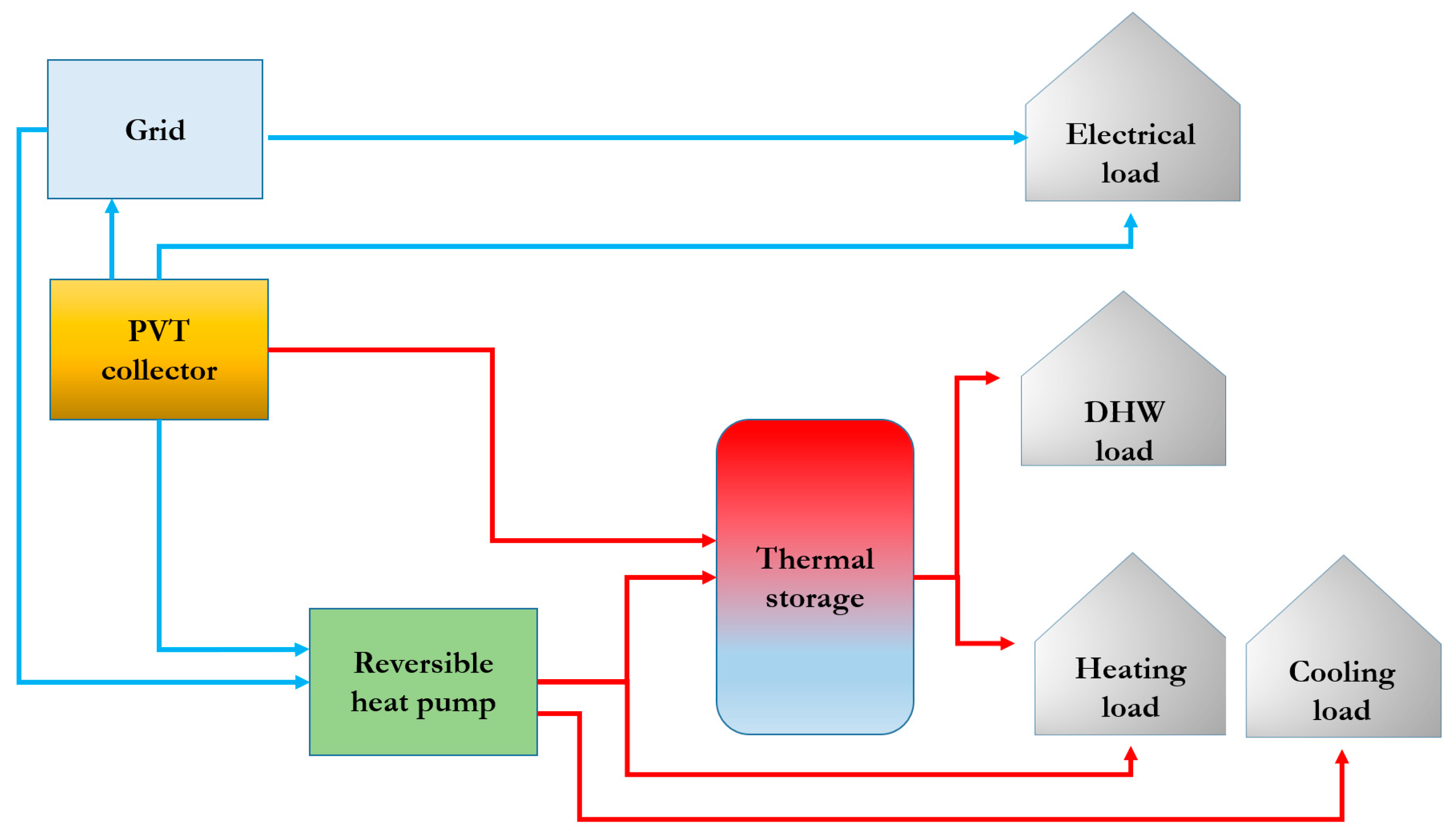
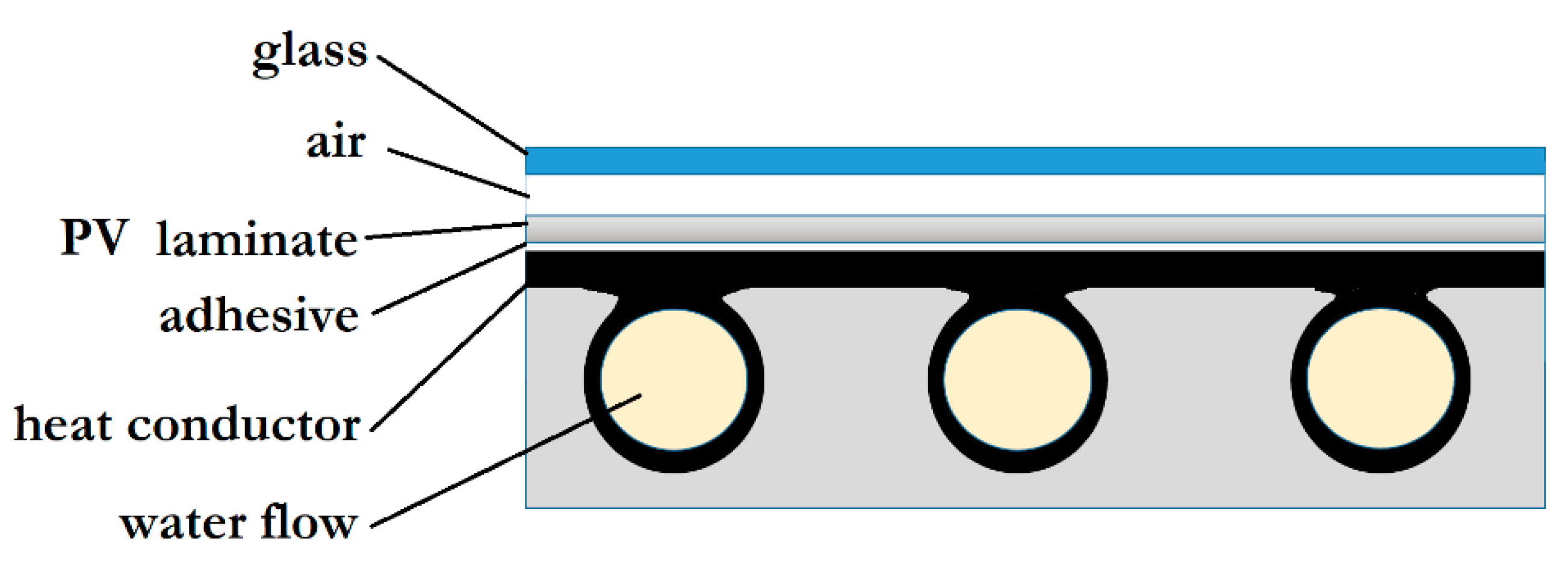
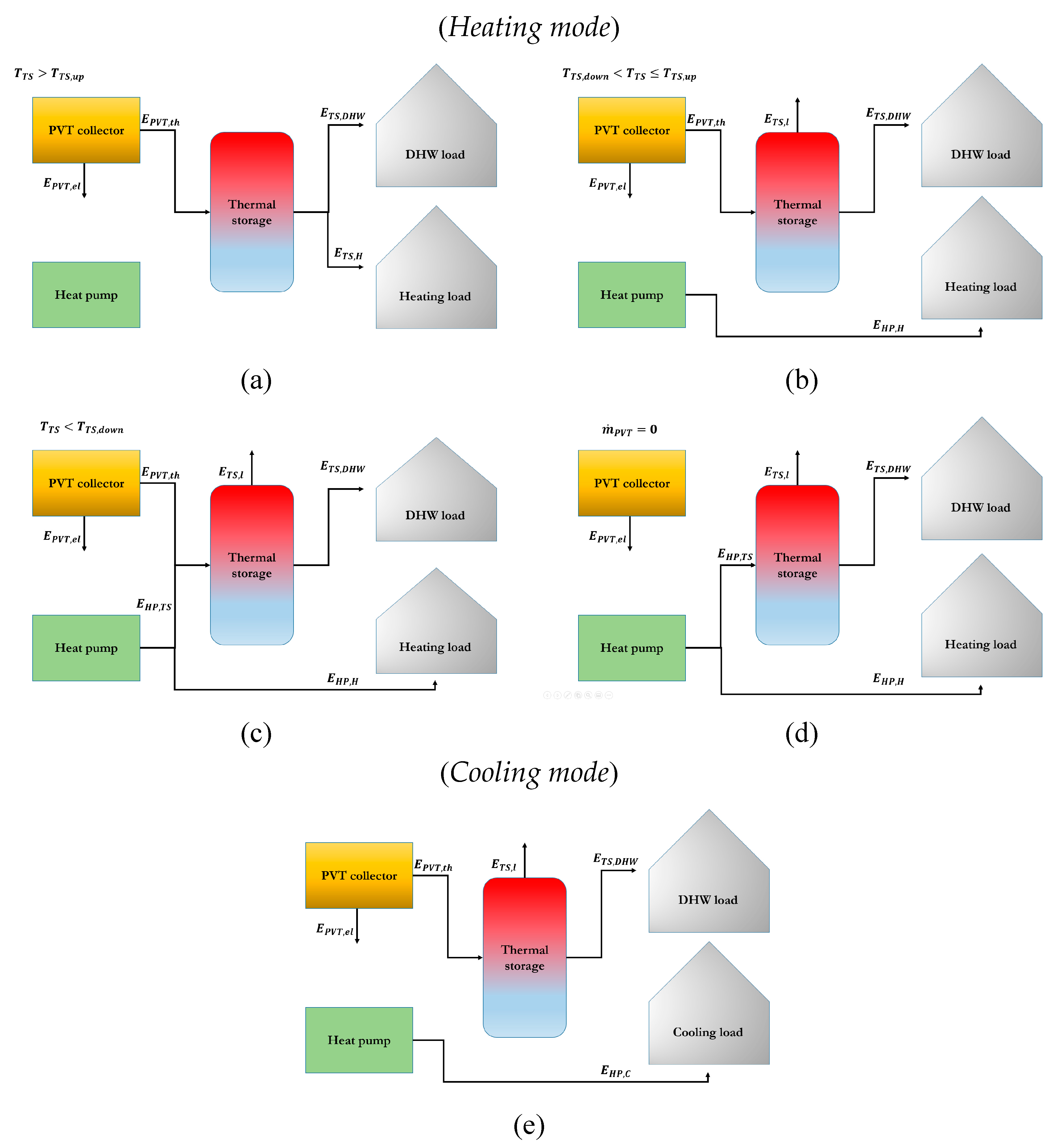
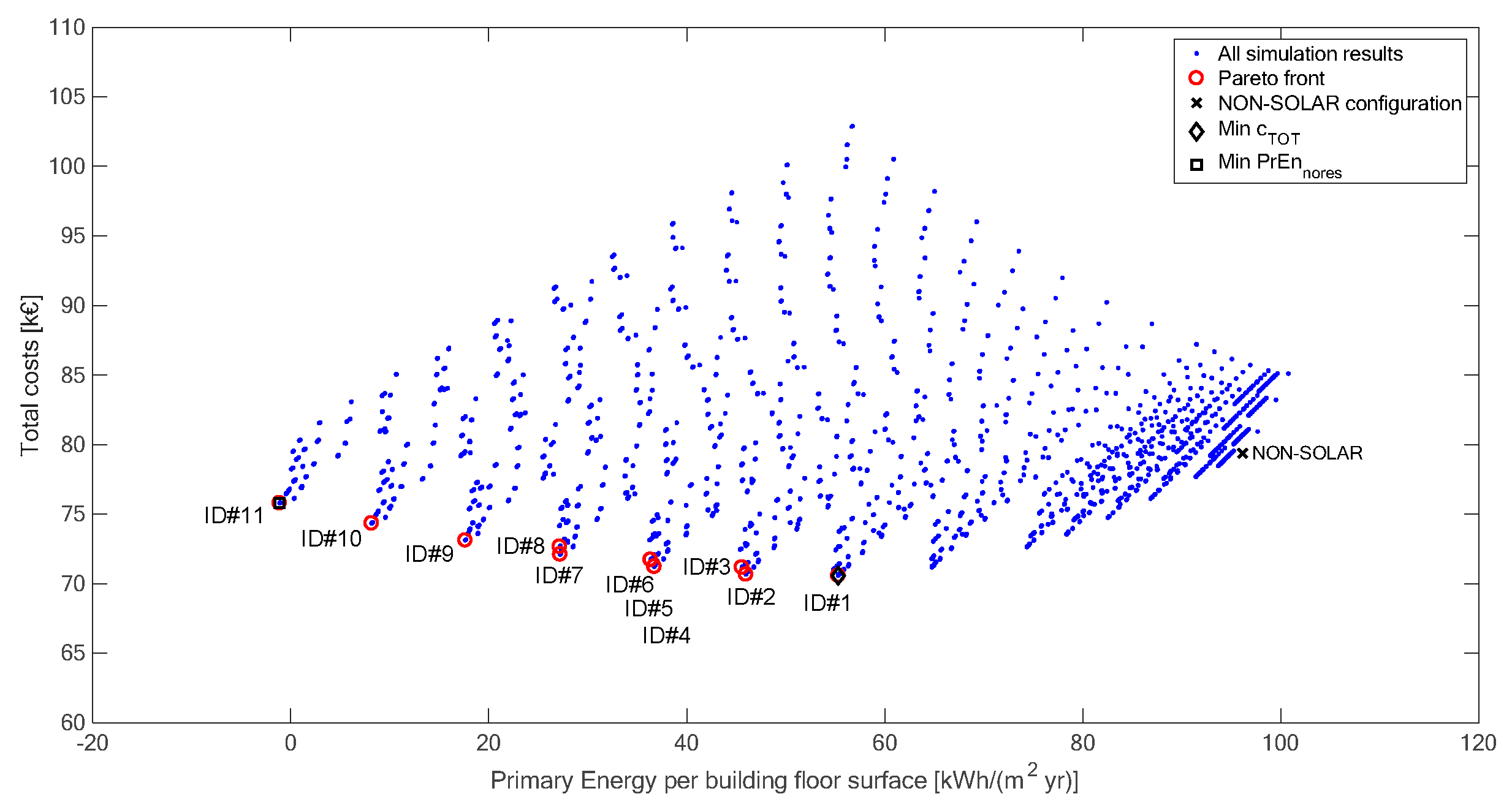
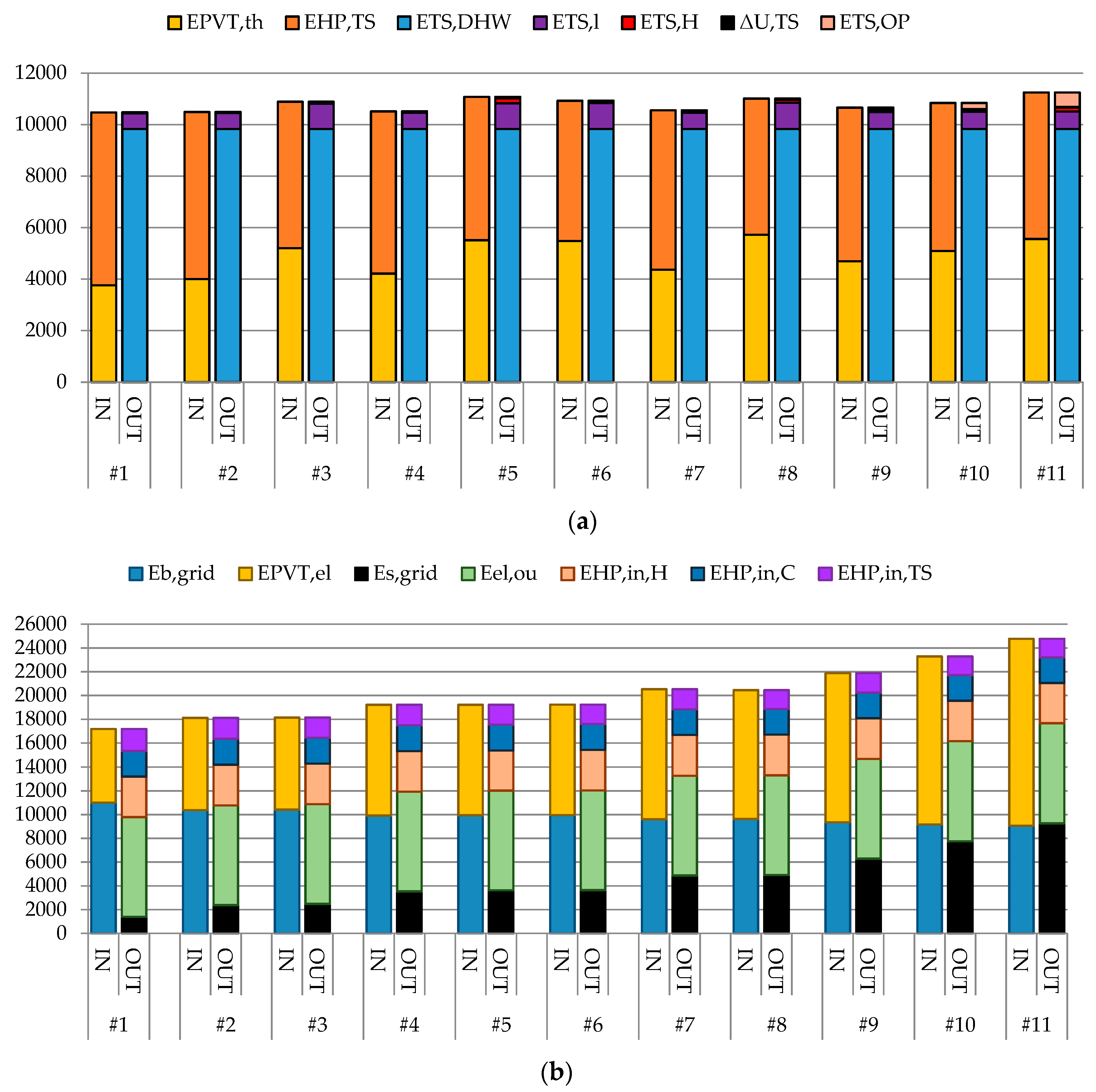

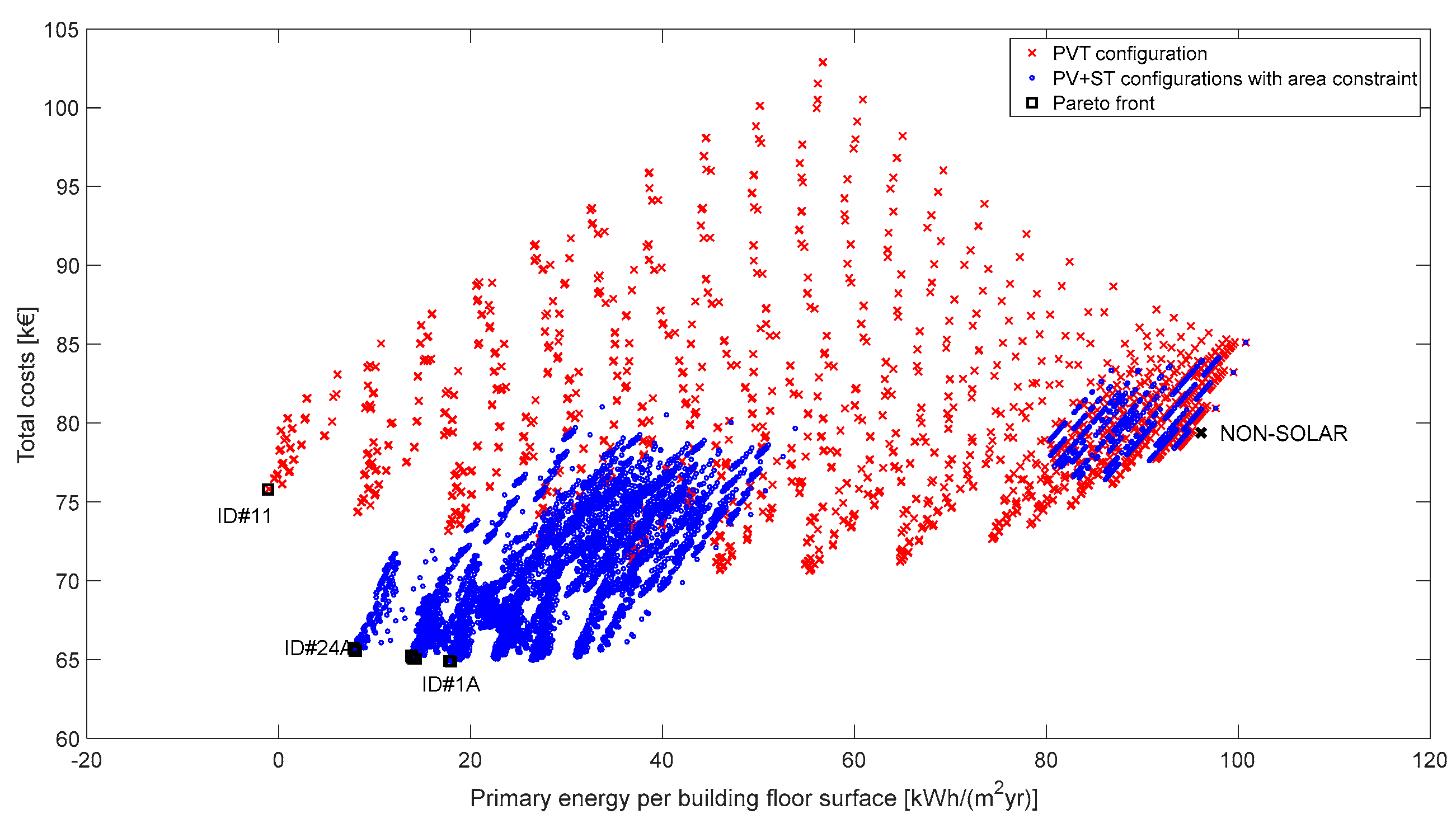
| Parameter | Jan. | Feb. | Mar. | Apr. | May | Jun. | Jul. | Aug. | Sep. | Oct. | Nov. | Dec. |
|---|---|---|---|---|---|---|---|---|---|---|---|---|
| [°C] | 7.8 | 8.2 | 9.6 | 11.9 | 18.9 | 25.4 | 26.9 | 25.4 | 20.7 | 17.3 | 14.9 | 9.1 |
[kWh/(m2·day)] | 2.69 | 3.09 | 4.31 | 4.76 | 6.54 | 7.07 | 6.81 | 6.60 | 4.96 | 3.84 | 2.38 | 2.32 |
| Heating Energy Requirement [kWh/yr] | Cooling Energy Requirement [kWh/yr] | DHW Energy Requirements [kWh/yr] | Electrical Energy Requirements (Excluding HP Requirements) [kWh/yr] |
|---|---|---|---|
| 13,683 | 8093 | 9832 | 8395 |
| ID | [-] | [m3] | [°C] | [deg] | [deg] | [kWh/(m2·yr)] | [k€] | [k€] | [c€/kWh] | [%] | [-] | [%] |
|---|---|---|---|---|---|---|---|---|---|---|---|---|
| non-solar | - | 0.5 | 70 | - | - | 96.1 | 79.4 | 12.5 | n/a | n/a | 1.32 | - |
| ID#1 | 20 | 0.5 | 70 | −90 | 20 | 55.3 | 70.6 | 28.5 | 8.7 | 42 | 2.30 | 31 |
| ID#2 | 25 | 0.5 | 70 | −90 | 20 | 46.0 | 70.7 | 32.5 | 8.1 | 52 | 2.77 | 27 |
| ID#3 | 25 | 1.0 | 60 | −90 | 20 | 45.6 | 71.2 | 33.0 | 8.2 | 53 | 2.79 | 25 |
| ID#4 | 30 | 0.5 | 70 | −90 | 20 | 36.7 | 71.2 | 36.5 | 7.7 | 62 | 3.47 | 22 |
| ID#5 | 30 | 1.0 | 50 | −90 | 20 | 36.4 | 71.7 | 37.0 | 7.7 | 62 | 3.50 | 21 |
| ID#6 | 30 | 1.0 | 60 | −90 | 20 | 36.3 | 71.7 | 37.0 | 7.7 | 62 | 3.50 | 21 |
| ID#7 | 35 | 0.5 | 70 | −90 | 20 | 27.2 | 72.1 | 40.5 | 7.3 | 72 | 4.68 | 18 |
| ID#8 | 35 | 1.0 | 55 | −90 | 20 | 27.2 | 72.7 | 41.0 | 7.4 | 72 | 4.69 | 16 |
| ID#9 | 40 | 0.5 | 70 | −90 | 20 | 17.6 | 73.1 | 44.5 | 7.1 | 82 | 7.22 | 14 |
| ID#10 | 45 | 0.5 | 70 | −90 | 20 | 8.2 | 74.3 | 48.5 | 6.9 | 92 | 15.60 | 10 |
| ID#11 | 50 | 0.5 | 60 | −90 | 20 | −1.1 | 75.8 | 52.5 | 6.7 | 101 | - | 7 |
| Parameter | Non-Solar | ID#1 | ID#11 |
|---|---|---|---|
| 9832 | 9832 | 9832 | |
| 10,391 | 6716 | 5693 | |
| 2754 | 1826 | 1562 | |
| 3.77 | 3.68 | 3.64 | |
| 3.57 | 5.38 | 6.29 |
| Parameter | ID. | Jan | Feb | Mar | Apr | May | Jun | Jul | Aug | Sep | Oct | Nov | Dec |
|---|---|---|---|---|---|---|---|---|---|---|---|---|---|
| - | Thermal Quantities | ||||||||||||
| ID#1 | 11 | 93 | 229 | 458 | 652 | 795 | 862 | 450 | 178 | 30 | 0 | 11 | |
| ID#11 | 17 | 189 | 425 | 803 | 876 | 1024 | 1081 | 721 | 358 | 62 | 1 | 17 | |
| ID#1 | 0 | 6 | 25 | 52 | 84 | 104 | 119 | 128 | 84 | 45 | 18 | 2 | |
| ID#11 | 0 | 2 | 15 | 22 | 30 | 31 | 39 | 33 | 32 | 23 | 10 | 2 | |
| ID#1 | 0 | 1 | 5 | 12 | 25 | 36 | 43 | 47 | 25 | 10 | 2 | 0 | |
| ID#11 | 0 | 0 | 4 | 9 | 18 | 19 | 22 | 24 | 16 | 8 | 1 | 0 | |
| ID#1 | 0 | 0.08 | 0.14 | 0.16 | 0.19 | 0.22 | 0.23 | 0.25 | 0.22 | 0.17 | 0.08 | 0.01 | |
| ID#11 | 0 | 0.14 | 0.19 | 0.28 | 0.35 | 0.40 | 0.39 | 0.49 | 0.37 | 0.26 | 0.12 | 0.01 | |
| ID#1 | 49.0 | 48.9 | 49.8 | 51.2 | 55.3 | 59.1 | 60.7 | 56.2 | 53.6 | 51.5 | 49.2 | 48.9 | |
| ID#11 | 49.0 | 48.8 | 51.2 | 55.8 | 64.7 | 64.8 | 65.4 | 62.0 | 62.0 | 56.4 | 49.9 | 48.9 | |
| ID#1 | 20.9 | 19.7 | 22.7 | 26.6 | 33.9 | 39.7 | 42.6 | 40.9 | 34.7 | 30.0 | 24.2 | 20.8 | |
| ID#11 | 20.9 | 19.6 | 22.5 | 25.8 | 32.5 | 38.1 | 41.1 | 39.4 | 33.8 | 29.6 | 24.1 | 20.8 | |
| - | Electrical Quantities | ||||||||||||
| ID#1 | 319 | 382 | 533 | 555 | 709 | 720 | 751 | 693 | 541 | 426 | 292 | 254 | |
| ID#11 | 798 | 958 | 1339 | 1411 | 1818 | 1849 | 1926 | 1778 | 1378 | 1075 | 733 | 634 | |
| ID#1 | 310 | 284 | 340 | 347 | 403 | 390 | 403 | 380 | 330 | 341 | 316 | 307 | |
| ID#11 | 310 | 284 | 340 | 347 | 403 | 390 | 403 | 380 | 330 | 341 | 316 | 307 | |
| ID#1 | 66 | 80 | 111 | 116 | 148 | 150 | 157 | 144 | 113 | 89 | 61 | 53 | |
| ID#11 | 66 | 80 | 112 | 118 | 152 | 154 | 160 | 148 | 115 | 90 | 61 | 53 | |
| ID#1 | 0.12 | 0.12 | 0.12 | 0.11 | 0.11 | 0.11 | 0.10 | 0.11 | 0.11 | 0.11 | 0.12 | 0.12 | |
| ID#11 | 0.12 | 0.12 | 0.12 | 0.11 | 0.11 | 0.11 | 0.11 | 0.11 | 0.11 | 0.11 | 0.12 | 0.12 | |
| Characteristics of the Configurations Using PVT Modules | |||||||
| ID | [-] | [m2] | [m3] | [°C] | [deg] | [deg] | [kWh/(m2·yr)] |
| ID#11 | 50 | 79 | 0.5 | 60 | −90 | 20 | −1.1 |
[k€] | [k€] | [c€/kWh] | [%] | [-] | [%] | - | |
| 75.8 | 52.5 | 6.7 | 101 | n/a | 7 | ||
| Characteristics of the Configurations Using PV + ST Modules | |||||||
| ID | [-] | [m2] | [m3] | [°C] | [deg] | [deg] | [kWh/(m2·yr)] |
| ID#24A | 50/1 | 78 | 0.5 | 70 | −90 | 20/50 | 7.8 |
| ID#1A | 40/4 | 72 | 0.5 | 70 | −90 | 20/30 | 18.0 |
[k€] | [k€] | [c€/kWh] | [%] | [-] | [%] | - | |
| ID#24A | 65.8 | 38.5 | 5.4 | 92 | 16.3 | 35 | |
| #1A | 64.9 | 36.5 | 5.8 | 81 | 7.1 | 40 | |
| [kWh/yr] | Thermal Balance of the Thermal Storage | |||||||||||
| ID | ||||||||||||
| ID#11 | 5556 | 5693 | 674 | 9832 | 156 | 29 | ||||||
| ID#24A | 1853 | 8558 | 550 | 9832 | 0 | 29 | ||||||
| ID#1A | 6634 | 3922 | 649 | 9832 | 47 | 27 | ||||||
| Electrical Balance | ||||||||||||
| ID | ||||||||||||
| ID##11 | 9068 | 15,697 | 8395 | 3388 | 2155 | 1562 | 9265 | |||||
| ID#24A | 9754 | 14,867 | 8395 | 3416 | 2155 | 2258 | 8398 | |||||
| ID#1A | 9234 | 11,894 | 8395 | 3407 | 2155 | 1059 | 6112 | |||||
© 2019 by the authors. Licensee MDPI, Basel, Switzerland. This article is an open access article distributed under the terms and conditions of the Creative Commons Attribution (CC BY) license (http://creativecommons.org/licenses/by/4.0/).
Share and Cite
Conti, P.; Schito, E.; Testi, D. Cost-Benefit Analysis of Hybrid Photovoltaic/Thermal Collectors in a Nearly Zero-Energy Building. Energies 2019, 12, 1582. https://doi.org/10.3390/en12081582
Conti P, Schito E, Testi D. Cost-Benefit Analysis of Hybrid Photovoltaic/Thermal Collectors in a Nearly Zero-Energy Building. Energies. 2019; 12(8):1582. https://doi.org/10.3390/en12081582
Chicago/Turabian StyleConti, Paolo, Eva Schito, and Daniele Testi. 2019. "Cost-Benefit Analysis of Hybrid Photovoltaic/Thermal Collectors in a Nearly Zero-Energy Building" Energies 12, no. 8: 1582. https://doi.org/10.3390/en12081582
APA StyleConti, P., Schito, E., & Testi, D. (2019). Cost-Benefit Analysis of Hybrid Photovoltaic/Thermal Collectors in a Nearly Zero-Energy Building. Energies, 12(8), 1582. https://doi.org/10.3390/en12081582







